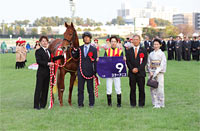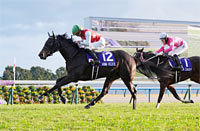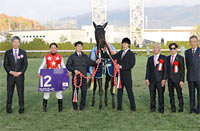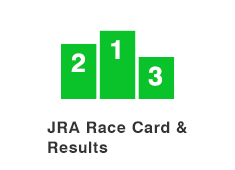Hanshin Juvenile Fillies (G1) - Data Analysis
Top decider for 2-year-old fillies
This race to decide the champion 2-year-old filly takes place on the 1,600m turf course at Hanshin, the same as the Oka Sho (Japanese 1000 Guineas) in the following year. Partly for this reason, the connections will be aiming for a result that gives promise for the spring. There have been 18 runners in this race every year since 2000, and a fierce battle is sure to unfold this year too; the runners will certainly need staying power to prevail in such conditions. Bearing that in mind, let’s now check trends in this race from results over the last 10 years.
Favored fillies dominate
Viewing aggregate performances in terms of favoritism over the last 10 years, all of the winners in that time have been among the top five favorites. The same goes for six of the 10 fillies finishing in both 2nd and 3rd place, and runners backed among the top five favorites also have clearly the best success ratios. Although those backed as 6th favorite or lower occasionally used to win this race before the outer course at Hanshin was created (i.e. up to 2005), there have been fewer success stories amongst less-favored fillies since the new course was introduced. [Table 1]
[Table 1] Performance by favoritism (last 10 years)
| Favoritism |
Performance
[1st-2nd-3rd-4th or lower] |
Win ratio |
Top 2 ratio |
Top 3 ratio |
| 1st favorite |
3-2-1-4 |
30.0% |
50.0% |
60.0% |
| 2nd favorite |
1-1-2-6 |
10.0% |
20.0% |
40.0% |
| 3rd favorite |
1-1-1-7 |
10.0% |
20.0% |
30.0% |
| 4th & 5th favorites |
5-2-2-11 |
25.0% |
35.0% |
45.0% |
| 6th & 7th favorites |
0-0-1-19 |
0% |
0% |
5.0% |
| 8th to 10th favorites |
0-3-3-24 |
0% |
10.0% |
20.0% |
| 11th favorite or lower |
0-1-0-79 |
0% |
1.3% |
1.3% |
Strong showing from fillies born earlier
If we then aggregate performances by runners over the last 10 years in terms of the month of their birth, we find that those born in January and February have had superior success ratios (discounting the small number born in May). Although a total of five winners were born in March and April, the large numbers of runners born in these months mean that they have lower success ratios. Perhaps the very fact that the runners are all 2-year-olds means that those “born earlier” have the advantage. [Table 2]
[Table 2] Performance by month of birth (last 10 years)
| Month of birth |
Performance
[1st-2nd-3rd-4th or lower] |
Win ratio |
Top 2 ratio |
Top 3 ratio |
| January |
2-4-0-15 |
9.5% |
28.6% |
28.6% |
| February |
2-2-5-26 |
5.7% |
11.4% |
25.7% |
| March |
2-1-2-55 |
3.3% |
5.0% |
8.3% |
| April |
3-2-2-46 |
5.7% |
9.4% |
13.2% |
| May |
1-1-1-8 |
9.1% |
18.2% |
27.3% |
Also check number of career starts
Nine of the last 10 winners came to this race on the back of two or three career starts. However, the largest number of starts for those finishing 2nd has been four, producing five runners-up. By contrast, runners with five or more career starts have had less success, and no filly with six or more starts has finished in the Top 3. [Table 3]
[Table 3] Performance by number of career starts (last 10 years)
| No. of career starts |
Performance
[1st-2nd-3rd-4th or lower] |
Win ratio |
Top 2 ratio |
Top 3 ratio |
| 1 |
1-1-2-12 |
6.3% |
12.5% |
25.0% |
| 2 |
5-1-2-19 |
18.5% |
22.2% |
29.6% |
| 3 |
4-2-3-59 |
5.9% |
8.8% |
13.2% |
| 4 |
0-5-2-32 |
0% |
12.8% |
17.9% |
| 5 |
0-1-1-13 |
0% |
6.7% |
13.3% |
| 6 or more |
0-0-0-15 |
0% |
0% |
0% |
Take a look at the previous race, too
Turning next to performances over the last 10 years in terms of the runners’ previous outing, the race producing the most Top 3 finishers here is the “KBS Kyoto Sho Fantasy Stakes.” Fillies coming straight from the “Artemis Stakes” at Tokyo Racecourse also have a fairly good record in this race. Four runners previously seen in the “5 million yen class (1-win class)” races have won this race, but in each case the race in question was either a “5 million yen class (1-win class) stakes race over 1,800m turf race at Kyoto Racecourse” or a “5 million yen class (1-win class) stakes race in the Kanto region.” Even if the previous outing was a 5 million yen class (1-win class) stakes race at Kyoto, performances here have been poor when the race in question was a turf race run over a distance of 1,600 meters or less. [Table 4]
[Table 4] Performance by previous race (last 10 years)
| Previous race |
Performance
[1st-2nd-3rd-4th or lower] |
Win ratio |
Top 2 ratio |
Top 3 ratio |
| GII |
1-1-1-6 |
11.1% |
22.2% |
33.3% |
| Fantasy Stakes |
1-3-3-40 |
2.1% |
8.5% |
14.9% |
| Artemis Stakes |
1-2-1-10 |
7.1% |
21.4% |
28.6% |
| Sapporo, Hakodate, Niigata
or Kokura Nisai Stakes |
1-1-0-9 |
9.1% |
18.2% |
18.2% |
| Open class (stakes) races |
0-0-1-14 |
0% |
0% |
6.7% |
| 5 million yen class (1-win class) stakes race over 1,800m turf race at Kyoto |
2-0-0-4 |
33.3% |
33.3% |
33.3% |
| 5 million yen class (1-win class) stakes race over 1,600m or less turf race at Kyoto |
0-1-0-18 |
0% |
5.3% |
5.3% |
| 5 million yen class (1-win class) stakes race in Kanto region |
2-1-1-14 |
11.1% |
16.7% |
22.2% |
| 5 million yen class (1-win class) race |
0-0-1-9 |
0% |
0% |
10.0% |
| Newcomer |
1-1-2-12 |
6.3% |
12.5% |
25.0% |
| Maiden |
1-0-0-11 |
8.3% |
8.3% |
8.3% |
| NAR race |
0-0-0-3 |
0% |
0% |
0% |
Check favoritism and finish in the 2nd career start
In this race, fillies that “won their 2nd career start as 1st favorite” have finished in the Top 2 in each of the last 10 years except 2009. For many of the runners in this race, the 2nd career start would have been a maiden race, and it would have been no mean feat to be backed as 1st favorite and then to win the race unless they had sufficient ability to warrant such evaluation. This must be even more so if the race in question was a 5 million yen class (1-win class) or an open class race. So it would be advisable to check out the “2nd career start” by this year’s runners as well. [Table 5]
[Table 5] Top 2 finishers with "wins as 1st favorite" in their 2nd career start (last 10 years)
| Year |
Finish |
Horse |
Race in question |
| 2006 |
2nd |
Aston Machan |
Maiden |
| 2007 |
1st |
Tall Poppy |
Maiden |
| 2008 |
1st |
Buena Vista |
Maiden |
| 2010 |
1st |
Reve d’Essor |
Daily Hai Nisai Stakes |
| 2011 |
2nd |
I’m Yours |
Maiden |
| 2012 |
2nd |
Kurofune Surprise |
Maiden |
| 2013 |
2nd |
Harp Star |
Niigata Nisai Stakes |
| 2014 |
1st |
Shonan Adela |
Maiden |
| 2015 |
1st |
Major Emblem |
Aster Sho |
Seek out the winner!
Check finishes and interval since debut race
Each of the last four winners finished in the Top 2 in their debut race, then entered their 2nd race after an interval of at least two months, and again finished in the Top 2 in that race. While the horse’s disposition is of course important, it would seem a good idea to focus on runners that have yielded good results after taking a sufficiently long break for recuperation. [Table 6]
[Table 6] Debut and 2nd race for last 4 winners
| Year |
Winning horse |
Debut race |
2nd race |
| 2012 |
Robe Tissage |
July 15 |
Newcomer, 1st |
November 10 |
Fantasy Stakes, 2nd |
| 2013 |
Red Reveur |
June 1 |
Newcomer, 1st |
August 31 |
Sapporo Nisai Stakes, 1st |
| 2014 |
Shonan Adela |
August 3 |
Newcomer, 2nd |
October 12 |
Maiden, 1st |
| 2015 |
Major Emblem |
June 14 |
Newcomer, 1st |
September 12 |
Aster Sho, 1st |
(Yasunori Asanoi)
|

- Preview
- Barrier draw
- Past performances of runners

- News
- Race result
- Video
- 2025 English

- 2024 English

- 2023 English

- 2022 English

- 2021 English

- 2020 English

- 2019 English

- 2018 English

- 2017 English

- 2016 English

- 2015 English

- 2014 English

- 2013 English

- 2012 English

- Photo Gallery
2025 Winner: Star Anise


2024 Winner: Arma Veloce


|



















